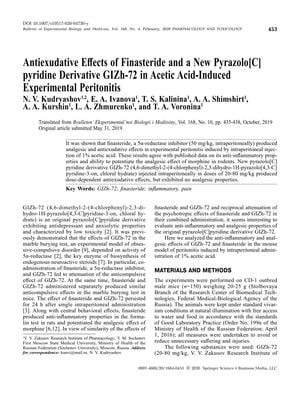TLDR Finasteride and GIZh-72 reduce inflammation, with GIZh-72 being more effective.
A study conducted on rodents found that both finasteride and a new pyrazolo[C]pyridine derivative called GIZh-72 had anti-inflammatory effects in mice with induced peritonitis. GIZh-72 was found to be more effective than finasteride, indicating its potential as a therapeutic agent for peritonitis. Finasteride also had analgesic effects and enhanced the analgesic effect of morphine in rodents. The study suggests that both finasteride and GIZh-72 have potential therapeutic applications in inflammatory diseases. However, further research is needed to confirm these findings.
 7 citations
,
March 2018 in “Dermatology and therapy”
7 citations
,
March 2018 in “Dermatology and therapy” Finasteride is considered the best treatment for hair loss, despite side effects.
 11 citations
,
September 2008 in “European Journal of Drug Metabolism and Pharmacokinetics”
11 citations
,
September 2008 in “European Journal of Drug Metabolism and Pharmacokinetics” Finasteride helps reduce pain and inflammation in animals.
 15 citations
,
March 2007 in “Hormones and Behavior”
15 citations
,
March 2007 in “Hormones and Behavior” Finasteride boosts morphine's pain relief, stops tolerance, and reduces withdrawal in rats.
 137 citations
,
March 2006 in “Cns Drug Reviews”
137 citations
,
March 2006 in “Cns Drug Reviews” Finasteride treats enlarged prostate and hair loss, but may cause side effects in some patients.
 11 citations
,
February 2004 in “Clinical and Experimental Ophthalmology”
11 citations
,
February 2004 in “Clinical and Experimental Ophthalmology” Taking Propecia might lead to the development of cataracts.
 June 2024 in “Georgetown medical review”
June 2024 in “Georgetown medical review” Finasteride treats hair loss but may cause low libido, erectile issues, and depression.
 June 2017 in “Reactions Weekly”
June 2017 in “Reactions Weekly” Finasteride (Propecia) may cause depression and suicidal thoughts; stop use and inform a healthcare professional if symptoms develop.
 3 citations
,
June 2004 in “Annales De Dermatologie Et De Venereologie”
3 citations
,
June 2004 in “Annales De Dermatologie Et De Venereologie” Four new cases of gynecomastia (male breast enlargement) linked to finasteride (Propecia) have been found.
2 citations
,
January 2003 in “Journal of Clinical Dermatology” 1 mg finasteride can cause reversible painful breast enlargement in men.
April 2012 in “Reactions Weekly” Finasteride may cause more sexual side effects than previously thought.








